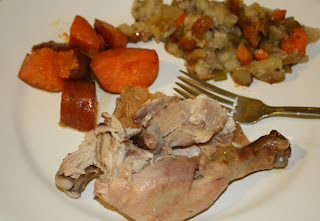It took me 15 days to make this bread.
It took me 15 days to make the sourdough starter that became this bread. 15 days of feedings, of worrying that it might not survive, of wondering what kind of character it would develop. That's right. It became my child for two weeks.
Clearly I'd make a horrible mother, since I forgot to feed it on schedule once or thrice. This is why I haven't reproduced. Anyway. My child turned out just fine, of course, getting stronger and less smelly over time. Its first two loaves were not great, tasting a lot like something that was baked in a Fisher-Price oven, but then came the third loaf. Pretty near perfect, and I'm not just saying that because I'm its mother.
In Breads from the La Brea Bakery, Nancy Silverton makes a simple statement that makes everything about bread baking infinitely more complicated: Bread is alive. The starter used to make it is born of wild yeasts and beneficial bacteria in the air. The starter has a metabolism, which is maintained through portion control and eating regular meals. It is temperamental and likes the room to be at a balmy 75 degrees. And it can be ornery-- it will be ready to bake when it is ready to bake, and not before.
It reminds me of someone I know.
I can't think of who it--
Oh right. Me.
The answer to your question is, "Because it tastes better." Commercial (i.e. active dry yeast that you buy at the grocery store) yeast makes the dough rise too quickly, like it's taking growth hormones or something. The flavor and character that are found in good loaves of sourdough bread come from the yeasts in the starter, and from the slow rise that happens as the starter is chomping on the starch in the flour. Silverton even says that starter created in New York, for example, won't have the same flavor as starter created here in the Bay Area, because the yeast varieties are different in the two regions.
It's like East Coast vs. West Coast rap, only with yeast.
I passed a bakery in Chicago once that offered baking classes. I stopped in to talk to the owner, who was a large, pasty, sweaty hulk of a man with a thick Eastern European accent. He was (a little too) excited to show me his starter, which was also large, pasty, and sweaty-looking, and I really didn't understand its purpose or his enthusiasm for this stinky glob. He said he drank some of the liquid daily for health, to which I silently replied that it clearly wasn't working.
I didn't take the classes from him.
But I do understand now why he was so excited about his starter, and why his having kept it alive for years is really quite impressive. I so should have taken his classes.
Raising and maintaining a starter is fairly easy, now that I've got the hang of it. I have a container of base starter that lies dormant in the refrigerator until I need it. I now use a sticky note on the lid of the container to keep track of feedings, and I start with a smaller quantity each time I want to bake, since
1 cup starter + [(1 cup water + 1 cup flour) x 3 times per day x 3 days] = enough starter to fill a swimming pool
As with all living things, though, the starter must go through the cycle of life. It is cute and bubbly as a child, then toughens a bit as it rises, and later takes on a distinct shape and size as it prepares for the oven. But as it bakes, the starter dies-- it is 450 degrees in there, after all-- and leaves behind its legacy in the form of a loaf with a crusty exterior, a chewy and irregular interior, and a note of pleasant sour.
Fortunately, its starter relatives are still alive in the fridge, and so it begins again.



























